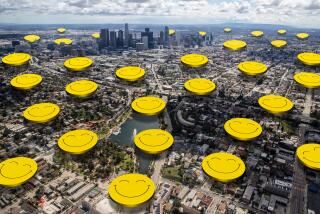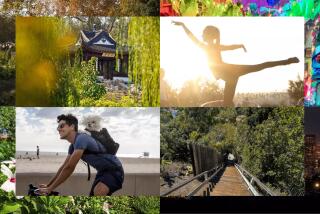Japanese Garden . . . A Place Where Peace Breaks Out
Imagine a place in Los Angeles where the cardinal virtues are considered to be humanity, justice, politeness, wisdom and fidelity. (Nope, not CAA.) Where every corner is shaped to reflect just such a philosophy and decades have gone into the master plan. (No, not Disney’s “Seven Dwarfs Holding Up the World.”) Where the air is cool and the only sound is water running over rounded stones or the bonggggging sound as a bamboo water pipe tips back to hit a waiting stone--the better to frighten wild boars.
Wild or otherwise, who wouldn’t welcome that device? Or a visit to such an airing-out spot? Amazingly enough, just such a secret garden has flourished for 30 years within blocks of the wheelings and dealings of the Hotel Bel-Air. And in among such pricey real estate, this two-acre Eden is open to the public, although in small numbers and by appointment, to be sure.
Last week, when the heat and the cupidity got really oppressive, I tried the perfected surroundings of this oasis--UCLA’s Hannah Carter Japanese Garden. Its effect turned out to be profound; long after the sounds of water on stones was gone, the hush of the place--quiet except for BMWs downshifting on Bellagio Road below--worked to unknot the mind.
The city has any number of pocket havens, with every kind of stimulation: UCLA’s Franklin Murphy Sculpture Garden, the Los Angeles County Museum’s new Japanese garden, the downtown New Otani’s rooftop gardens, the J. Paul Getty Museum’s gardens. But for quiet and introspection, you couldn’t touch the UCLA Japanese Garden. To wander the place with only three other visitors was to feel like another century’s ruling class, who kept their great private gardens private.
As the brochure suggests, a Japanese garden’s general plan is supposed to embody the cycle from wild youth to sedate maturity, in sequence. Thus the teahouse can be found on the downward, meditative, mature end of things, while the stone bath house and the outdoor, stream-fed sunken bath are a splash on the wild side.
It takes perhaps a half hour to really begin to see the garden, to slow down a harried Westerner’s abrupt glance so that details sink in. I suspect it takes generations to begin to understand such a garden’s symbolism, even superficially; to grasp such matters as the aesthetic behind the pond’s different pines: the “view-perfecting pine,” the “cascade screening tree,” the “stretching pine.” Then there’s the significance of the rocks and boulders, 400 tons of them brought here from Japan and placed by Japanese architect Nagao Sakurai, working through a translator and from some sure plan he kept entirely in his head, according to Gabriel Aguilera, part of the crew who helped set each plant and massive stone.
That was in 1959, when the garden was being created for oil man Gordon Green Guilberson, in memory of his mother, and in the general style of a Kyoto garden. It is a masterful accomplishment, although one can only wonder what Sakurai made of a request to keep the barbecue area; he did the best he could by insetting its counter walls with stone chrysanthemums and camellias. Fine old bonsai now take the curse off its California countertops.
In 1965, Broadway Department Store magnate and then-UC Regents Chairman Edward W. Carter donated the garden to UCLA, several of whose departments use it as a teaching tool. When the deluges of 1969 tore down hillsides, ripped out pines and bonfire maples and killed most of the pool’s koi (who can live to be 200), its reconstruction was designed by renowned landscape architect and designer Koichi Kawana. A professor at UCLA, Kawana, who died last September, also designed the LACMA Japanese Garden, as well as a 14-acre Japanese garden in St. Louis.
Walk through the UCLA Japanese garden with Aguilera, and this ordered world becomes a little less of a mystery. Lean and courtly, the Jalisco-born Aguilera is legendary. Officially the garden’s manager, in reality he has been the keeper of its spirit and its health for 30 years. In times of water rationing and budget cuts, Aguilera prunes and doctors and improvises, keeping everything going, somehow, with Jay Ross, his single assistant. Aguilera may worry that the huge gold and black and red koi are almost suffering from too-infrequent changes of their water, but he nurtures them with the same care he gives to trees whose symmetry he hand-shaped from the day he put them in the ground from 15-gallon cans.
Walk past a huge boulder near the start of the life-journey and it looks ancient and beautiful but unremarkable. Using a dipper tucked neatly out of sight, Aguilera splashes it with water from a rock-basin. Wet, the 400,000-year old stone, called “jade rock,” becomes celadon green. Outside the main arched entry gate, Aguilera kneels to show a detail underfoot: these black rocks were each hand-split to reveal their prized fan shape.
At the peak of the climb is the family shrine and, reaching it, my hand grasps one of the handsome, dome-shaped bronze finials that decorate the railing, and another memory floats up. One of my father’s closest friends was a fellow-New York artist, an illustrator named Will Crawford, whose distinctive quavery line drawings and gently funny historical cartoons decorated Harper’s and the old Life magazine in the ‘20s and ‘30s. There were endless stories about Crawford, who knew every kind of Indian lore, who could handcraft a bow and arrows, whose white mustache was always faintly yellowed from his pipe, and whose puckishness was unmatched.
Caught in a rainstorm as he was going home late one night, Crawford took refuge in a little alley doorway and, characteristically, took that moment to light his pipe. Reaching down to the dry bricks at knee level, he struck a match, then thought, “I bet I’m the only person who’s ever struck a match just here.” He held the match low, and saw the bricks scarred with perhaps two dozen other marks at just that height. And he roared at his high-flown notion of singularity.
Holding that bronze finial, I remembered Crawford’s story and looked at it closely. Of the eight or so identical bronze knobs around the railing, it alone was burnished from hundreds of hands that had reached for it, gratefully, at the top of the hill climb. And I smiled to be reminded again of Will Crawford and his gentle cautionary tale.
* The UCLA Hannah Carter Japanese Garden is open Tuesdays, 10 a.m. to 1 p.m., and Wednesdays, noon to 3 p.m. Because of the tiny parking area, reservations are necessary: UCLA Visitors Center (213) 825-4574.






